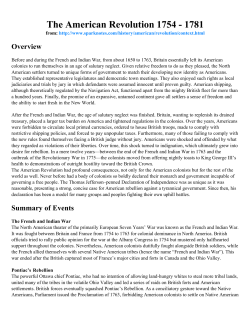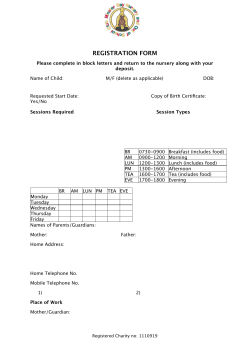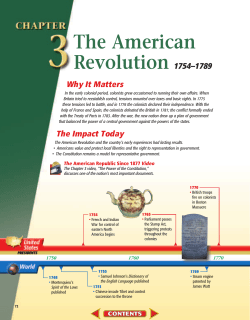
Unit 2 Review Game
Unit 2 Review Game 1. Two part question: (a) What caused the French & Indian War? (b) Name the two European nations that fought in the French & Indian War. 2. Two part question: (a) What was the name of the treaty that ended the French & Indian War in 1763? (b) Name one provision of this treaty. 3. Name 1 way the French & Indian War changed the relationship between Britain and their American colonies. 4. How was the French & Indian War an example of mercantilism? 5. What did Benjamin Franklin suggest when he proposed his Albany Plan of Union in 1754? (His proposal failed to pass, which revealed the lack of unity among the colonies before the French & Indian War) 6. What decision did Prime Minister William Pitt make during the French & Indian War that would lead to parliamentary sovereignty after the war was over? 7. Three part question: Define each term: (a) salutary neglect; (b) mercantilism; (c) parliamentary sovereignty 8. Two part question: (a) What was the Proclamation of 1763? (b) How was the decision to create the proclamation impacted by Pontiac’s Rebellion in 1763? 9. How was the end of the French & Indian War in 1763 the beginning of the American Revolution in 1776? 10. Put these 3 events in chronological order: (a) Lexington & Concord, (b) Intolerable Acts, (c) Stamp Act 11. Put these 3 events in chronological order: (a) Boycotting the Townshend Acts, (b) publication of Common Sense, (c) meeting of the First Continental Congress to protest the Intolerable Acts 12. Put these 3 events in chronological order: (a) French & Indian War, (b) Salutary Neglect, (c) Parliamentary Sovereignty 13. Two part question: (a) What was the Stamp Act? (b) How did the colonists respond to the Stamp Act? 14. Two part question: (a) What were the Townshend Acts? (b) How did the colonists respond to the Townshend Acts? 15. Two part question: (a) What were the Intolerable Acts? (b) How did the colonists respond to the Intolerable Acts? 16. What were the Sons of Liberty and the Daughters of Liberty? 17. What were Committees of Correspondence? 18. How did the Quartering Act help lead to the Boston Massacre? 19. How did the Townshend Acts help lead to the Boston Tea Party? 20. Why was the Boston Tea Party really just a serious misunderstanding? (How did the colonists misinterpret what Britain was trying to do in 1773?) 21. What was the most effective way the American colonists responded to British taxes, such as the Stamp Act and Townshend Acts? 22. Colonists decided to meet at the First Continental Congress in 1774 in order to respond to what action by the British government? 23. What incident between colonial minutemen and British soldiers proved to be the beginning of the American Revolution? 24. Why did the British army march from Boston to Lexington and Concord in 1775? 25. How did the Enlightenment help lead to the American Revolution? 26. Pick any two of the following Enlightenment thinkers and explain their key political idea: (a) John Locke, (b) Jean-Jacques Rousseau, (c) Baron de Montesquieu, (d) Thomas Paine, (e) Thomas Jefferson 27. Two part question: (a) Who wrote Common Sense? (b) Who was the principal author of the Declaration of Independence? 28. The Declaration of Independence is based upon the ideas of which European Enlightenment thinker? 29. Three part question: (a) What is a “patriot”? (b) What is a “loyalist”? (c) What is a “neutral”? 30. Name two advantages of the British military at the outbreak of the American Revolution. 31. Name two advantages of the American Continental Army at the outbreak of the American Revolution 32. Two part question: (a) Who was the American in charge of the Continental Army? (b) Who was the French general who helped train American soldiers during the war? 33. George Washington gained a victory at Trenton, New Jersey after his Christmas Eve surprise attack on unsuspecting British soldiers. This attack (across a river) has become famously referred to a “Washington crossing the…” 34. Two part question: (a) Which European country did the Americans try to ally with during the Revolutionary War? (b) Who was the American diplomat who successfully negotiated this alliance? 35. Why was Saratoga the “turning point” battle of the Revolutionary War? 36. What was the name of the fort where Washington’s army was stationed during the winter of 1777-78? 37. Two part question: During the American Revolution, (a) who was Lafayette? (b) who was Cornwallis? 38. Place these battles of the American Revolution in the correct chronological order: Saratoga, Yorktown, Lexington/Concord 39. Why was Yorktown an important battle during the Revolutionary War? 40. Name two provisions (parts) of the Treaty of Paris, 1783 (that ended the American Revolution): Unit 2 Review Game—THE ANSWERS 1. (a) Competition over the Ohio River Valley; Imperialism rivalry between Britain and France; George Washington’s attack on the French Fort Duquesne. (b) Britain/American colonists vs. France/Indian allies 2. (a) The Treaty of Paris, 1763; (b) France lost all territory in North American including Canada and Louisiana, Britain gained Canada, Florida, and all lands east of the Mississippi River, and Spain gained Louisiana. 3. The war increased British debts which led to new taxes on the colonies; The war led to a shift from salutary neglect before the war to parliamentary sovereignty after the war; Britain gained new lands from France but did not allow colonists to move across the Appalachian Mountains; 4. Britain used the French & Indian War as an opportunity to remove their chief economic rival, the French, from America; The French & Indian War was also known as the “Seven Years War” because part of the war was fought in Europe to determine which European nations would be dominant. 5. He proposed the creation of a colonial army to defend colonists from Indian attacks like the Iroquois. 6. Pitt was responsible for the “blank check” (spend whatever it takes to win the war) in order to defeat France. This decision led to massive British debts and the need to tax the colonists without their approval. 7. (a) “Beneficial ignoring” meant that Britain did not strictly control the North American colonies and allowed them to create their own colonial assemblies. Salutary neglect was the norm BEFORE the French and Indian War; (b) The colonies should benefit the mother country; Strong nations have favorable balances of trade (more exports than imports); Colonial trade is regulated by Britain. This was the norm before and after the French and Indian War; (c) Parliament has absolute authority over the colonies and will strictly control laws and taxes; This was the norm AFTER the French & Indian War. 8. (a) Britain created the Proclamation Line in order to keep colonists out of Indian lands west of the Appalachian Mountains in order to protect colonists from Indian attacks and to save Britain money; (b) Pontiac’s Rebellion (of the Ottawa Indians) showed how ineffective the British were in stopping Indian attacks. 9. When the French & Indian War ended in 1763, salutary neglect ended and parliamentary sovereignty began. This was the beginning of British taxes and laws make by Parliament and not by colonial assemblies. 10. This is the order: Stamp Act, Intolerable Acts, Lexington/Concord 11. This is the order: Boycotting the Intolerable Acts, First Continental Congress, Common Sense 12. This is the order: Salutary Neglect, French & Indian War, Parliamentary Sovereignty 13. (a) A tax on paper goods such as newspapers, playing cards, marriage licenses; This tax revenue was used to pay down British debts; (b) Colonists boycotted and protested the Stamp Act; Formed the Stamp Act Congress; Proclaimed “no taxation without representation” 14. (a) An “indirect” tax on the manufacture of lead, glass, paper, tea that the Americans were no supposed to notice. (b) Colonists boycotted any good that was taxed and threatened tax collectors. 15. (a) Also known as the Coercive Acts; A series of laws that punished Bostonians from the Boston Tea Party. Punishments included closing Boston harbor, ending the colonial assembly, demanding full repayment of destroyed tea; (b) Colonists formed the First Continental Congress to organize a resistance to the Intolerable Acts; All the colonies united to smuggle goods in and out of Boston and continued to boycott British goods as a sign of protest 16. These were groups of colonists who protested British tax laws, led the boycotts, and became radical patriots in their class for independence. Leaders of the Sons of Liberty included Samuel Adams and John Hancock. 17. Groups formed by colonists in an attempt to communicate what was happening throughout the colonies. These committees were formed by the Sons of Liberty. Committees were present in each of the 13 colonies and provided a network of communication. 18. The Quartering Act required citizens to house British troops (to save Britain money). The Boston Massacre occurred when angry colonists threw snowballs (and oyster shells) at British troops. This snowball fight was a demonstration of colonial frustration by the presence of the British army. The massacre occurred when the soldiers fired into the crowd to protect themselves from the angry and violent colonial mob. 19. The Townshend Acts created indirect taxes on colonial goods that the British did not think the colonists would notice. One of these taxes was on tea. The Boston Tea Party occurred when colonists thought they were being tricked again. Also, the colonists thought that the Tea Act of 1773, which lowered the cost of tea, was a way to get the colonists to pay the tax on tea created by the Townshend Acts. All of the other Townshend Act taxed had been repealed, except the tax on tea. 20. The Tea Act of 1773 was really an attempt by Britain to help the British East India Company. By lowering the price of tea, Britain assumed more people would buy tea. But the colonists assumed that this was a trick to get them to pay the only remaining tax left over from the repealed Townshend Act…a tax on tea. 21. Boycotting 22. Intolerable Acts (Coercive Acts) 23. Lexington and Concord 24. To arrest Sam Adams and John Hancock, leaders of the Sons of Liberty, and to seize weapons stored by colonists. 25. Many of the ideas from the European Enlightenment were about citizens opposing “tyranny.” By 1776, many colonists began to think of the British government was tyrannical (too powerful and abusive). 26. Any two will do: (a) Locke—people have natural rights to live, liberty, and property; Citizens have a right to overthrow tyrannical governments; (b) Rousseau—citizens form a social contract with their government and agree to obey the law as long as the government does not abuse its citizens; (c) Montesquieu—power should be separated into three branches of government, each with its own power over the other two; (d) Paine—it is “common sense” for American colonists to demand independence from Britain; (e) Jefferson—wrote the Declaration of Independence based upon natural rights of life, liberty, and the pursuit of happiness and the desire for democracy. 27. (a) Thomas Paine; (b) Thomas Jefferson 28. John Locke 29. (a) An American colonist who supported independence from Britain; (b) a colonist who wanted to remain loyal to Britain and did not support independence; (c) colonists who were not sure about which side to support 30. Any two will do: 400% larger army than the American military; most dominant navy in the world, experienced solders and officers, a strong manufacturing base to make weapons 31. Any two will do: Familiarity with the environment, a commitment to win the war, short supply lines to their soldiers, a defensive strategy to outlast the British, The British had to find & defeat the Continental Army to win 32. (a) George Washington; (b) Lafayette 33. Delaware (or the Delaware River) 34. (a) France; (b) Benjamin Franklin 35. Because this American victory allowed France to commit to an alliance with America. 36. Valley Forge, Pennsylvania 37. (a) Lafayette was French general who assisted Washington, train and direct the American/French armies against the British; (b) Cornwallis was the British general who surrendered to Washington at Yorktown. 38. Order: (1) Lexington & Concord, (2) Saratoga, (3) Yorktown 39. This was the “last battle” of the American Revolution. 40. Any two will do: America gained independence, America gained all lands east of the Mississippi (everything from the colonies to the Mississippi River became the USA); Spain got Florida; Britain kept Canada; France got nothing (even though they helped America).
© Copyright 2025





















